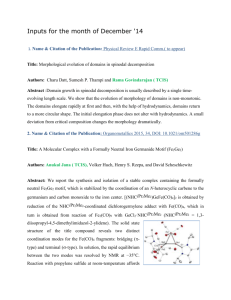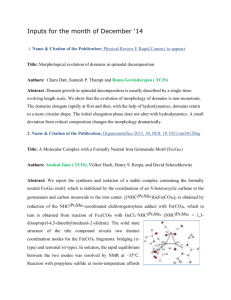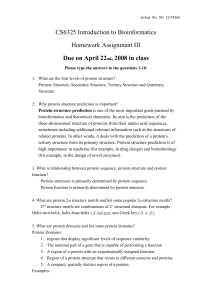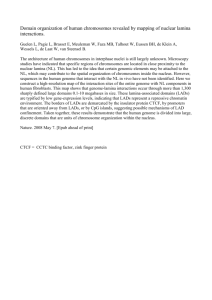Table T1 - Genetics
advertisement
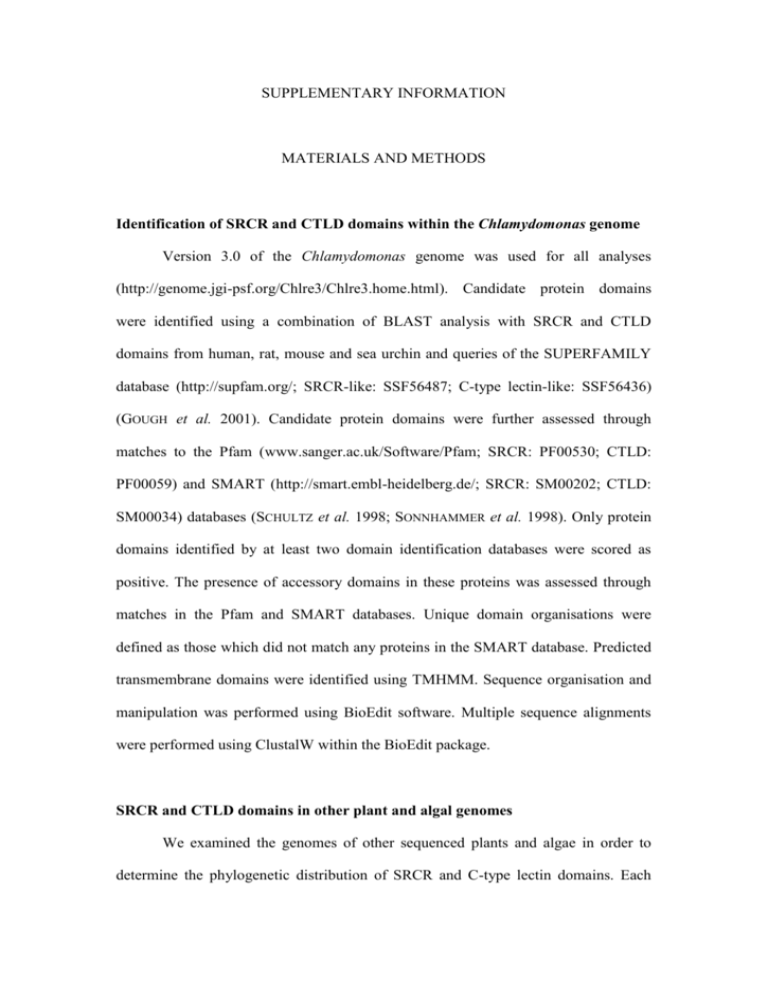
SUPPLEMENTARY INFORMATION
MATERIALS AND METHODS
Identification of SRCR and CTLD domains within the Chlamydomonas genome
Version 3.0 of the Chlamydomonas genome was used for all analyses
(http://genome.jgi-psf.org/Chlre3/Chlre3.home.html). Candidate protein domains
were identified using a combination of BLAST analysis with SRCR and CTLD
domains from human, rat, mouse and sea urchin and queries of the SUPERFAMILY
database (http://supfam.org/; SRCR-like: SSF56487; C-type lectin-like: SSF56436)
(GOUGH et al. 2001). Candidate protein domains were further assessed through
matches to the Pfam (www.sanger.ac.uk/Software/Pfam; SRCR: PF00530; CTLD:
PF00059) and SMART (http://smart.embl-heidelberg.de/; SRCR: SM00202; CTLD:
SM00034) databases (SCHULTZ et al. 1998; SONNHAMMER et al. 1998). Only protein
domains identified by at least two domain identification databases were scored as
positive. The presence of accessory domains in these proteins was assessed through
matches in the Pfam and SMART databases. Unique domain organisations were
defined as those which did not match any proteins in the SMART database. Predicted
transmembrane domains were identified using TMHMM. Sequence organisation and
manipulation was performed using BioEdit software. Multiple sequence alignments
were performed using ClustalW within the BioEdit package.
SRCR and CTLD domains in other plant and algal genomes
We examined the genomes of other sequenced plants and algae in order to
determine the phylogenetic distribution of SRCR and C-type lectin domains. Each
genome was searched by 1) BLAST analysis with Chlamydomonas and human
domains; 2) keyword searches; and 3) SUPERFAMILY genome assignments. In
addition, SMART and Pfam databases were searched.
Identification of putative Tyrosine Kinase domains
The multi-level HMM library was applied uniformly to the set of 15,256
peptides (C. reinhardtii genome build v.3.0) under the HMMER software suite
(http://hmmer.janelia.org), correcting for database size. The automatically-retrieved
sequences were inspected individually, and group-level classification was done by
applying the E-value cut-off for the characterised groups across the kinomes of H.
sapiens, C. elegans, D. melanogaster and S. cerevisiae (MIRANDA-SAAVEDRA and
BARTON 2007). Sequence comparison and clustering were carried out with the AMPS
suite of programs (BARTON and STERNBERG 1987). The search for accessory domains
in the putative tyrosine kinases of Chlamydomonas was performed by interrogating
InterPro with a local installation of InterProScan using default parameters (ZDOBNOV
and APWEILER 2001). The presence of SH2 domains was investigated by using the
SUPERFAMILY (SSF55550), Pfam (PF00017) and SMART (SM00252) models.
SUPPLEMENTARY DATA
Table T1:
Proteins containing scavenger receptor cysteine rich (SRCR) and C-type lectin
(CTLD) domains found in the Chlamydomonas genome. Predicted transmembrane
domains (TM) were identified by TMHMM. The organisation of accessory domains
identified by either Pfam or SMART databases is also shown. Domains are ordered
from N-terminus to C-terminus. CHT- chitin binding domain type2, EGF2 epidermal growth factor like, FA58C - coagulation factor 5/8 type, FG-GAP - FGGAP repeat, GH18 - glycosyl hydrolase family 18, KR - Kringle, LDLA - low density
lipoprotein receptor type A, LRR - leucine-rich repeat, LYSM - lysin, PAN PAN/Apple, PBH1 - parallel beta-helix repeat, PK - protein kinase, PMP polymorphic membrane protein, RVE - integrase core domain, TRPSC - trypsin-like
serine protease, VOM - vitelline membrane outer layer protein I.
Table T2:
List of putative tyrosine kinases found in the Chlamydomonas genome. The predicted
kinase catalytic activity of protein kinases is based on the identification of key amino
acid residues known to be responsible for the phosphotransfer reaction. These include
the lysine ('K') of the 'VAIK' motif (subdomain II), in which the lysine interacts with
the alpha and beta phosphates of ATP, anchoring and orienting the ATP molecule; the
HRD motif (D1) (subdomain VIb), in which the aspartic acid is the catalytic residue,
functioning as a base acceptor to achieve proton transfer; and the DFG motif (D2)
(subdomain VII), in which the aspartic acid binds the Mg2+ ions that coordinate the
beta and gamma phosphates of ATP in the ATP-binding cleft. Only two of the 28
putative tyrosine kinases of Chlamydomonas were found to have identifiable
accessory domains in addition to the kinase catalytic domain. Domains are ordered
from N-terminus to C-terminus.
Figure S1:
The SH2 domains from Chlamydomonas and Volvox contain conserved residues
important for phosphotyrosine binding. A sequence alignment of the SH2 domains
from Chlamydomonas and Volvox is displayed with SH2 domains from plants
(Arabidopsis), slime molds (Dictyostelium), metazoans (humans) and viruses. The
canonical SH2 domain, containing the conserved arginine residue important in
phosphotyrosine binding, is present in all sequences (boxed) (WILLIAMS and
ZVELEBIL 2004). The Chlamydomonas and Volvox SH2 domains were identified by
hits to the SMART SH2 model (SM00252).
REFERENCES
BARTON, G. J., and M. J. STERNBERG, 1987 A strategy for the rapid multiple
alignment of protein sequences. Confidence levels from tertiary structure
comparisons. J Mol Biol 198: 327-337.
GOUGH, J., K. KARPLUS, R. HUGHEY and C. CHOTHIA, 2001 Assignment of homology
to genome sequences using a library of hidden Markov models that represent
all proteins of known structure. J Mol Biol 313: 903-919.
MIRANDA-SAAVEDRA, D., and G. J. BARTON, 2007 Classification and functional
annotation of eukaryotic protein kinases. Proteins 68: 893-914.
SCHULTZ, J., F. MILPETZ, P. BORK and C. P. PONTING, 1998 SMART, a simple
modular architecture research tool: identification of signaling domains. Proc
Natl Acad Sci U S A 95: 5857-5864.
SONNHAMMER, E. L., S. R. EDDY, E. BIRNEY, A. BATEMAN and R. DURBIN, 1998
Pfam: multiple sequence alignments and HMM-profiles of protein domains.
Nucleic Acids Res 26: 320-322.
WILLIAMS, J. G., and M. ZVELEBIL, 2004 SH2 domains in plants imply new signalling
scenarios. Trends Plant Sci 9: 161-163.
ZDOBNOV, E. M., and R. APWEILER, 2001 InterProScan--an integration platform for
the signature-recognition methods in InterPro. Bioinformatics 17: 847-848.
